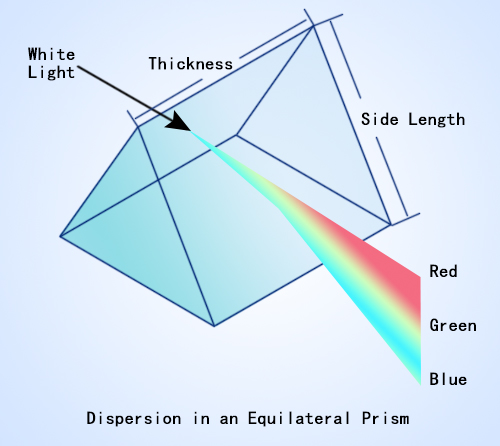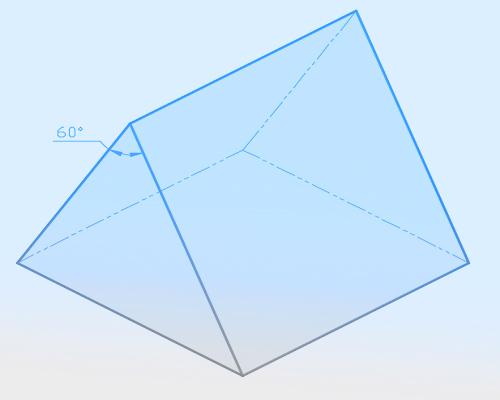Specifications:
| Material | N-BK7, UV Fused Silica, SF11, N-SF11, CaF2, MaF2, ZnSe, F2, N-F2 | Clear Aperture | 90% |
| Dimension Tolerance | +0.0/-0.2mm, or ±0.15mm | Surface Quality | 60/40, 40/20, 20/10, 10/5 S/D |
| Angle Tolerance | 60°±3 arc minutes | Flatness | <λ/4, <λ/8, <λ/10@632.8nm |
| Polished Surface | Three side surfaces polished | Chamfer | Protective<0.5mmx45° |
| Coating | Uncoated or Custom |
Equilateral Prisms are triangular optical prisms each that has three identical side lengths and three 60°apex angles. Equilateral prisms are often utilized for dispersive purposes (i.e. separating a white light source into a spectrum of multiple colors). Depending on the substrate materials, equilateral dispersive prisms could be selected to break up different spectral regions. To some extent, equilateral prism functions just like a diffraction grating, only that the prisms present better brightness, greater endurance to power, and fewer problems associated with higher orders.
Hangzhou Shalom EO offers Custom Equilateral Prisms made from a wide assortment of materials, and high-refractive-index materials including N-BK7, UV Fused Silica, SF11, N-SF11, CaF2, MaF2, ZnSe, F2, N-F2, etc. The transmission range of these materials spans from ultra-violet, visible, to infrared. Anti-reflection coatings with specified bandwidths are available to reduce the loss at the prism-to-air interface for high-refraction materials, Anti-reflection coatings with specified bandwidths are available to reduce the loss at the prism-to-air interface for high-refraction materials, with the additional strength to protect the equilateral dispersive prism from chemical corrosions and other contaminants. As a sophisticated supplier of optical components, we are confident in providing a series of equilateral prisms with a wide selection of specifications, we are capable of delivering both high-precision prisms with tight geometric bridles and standard-grade prisms for requirements that are less challenging. The surface qualities of our custom equilateral prisms could be 60/40, 40/20, 20/10, 10/5 S/D, and the flatness <λ/4, <λ/8, <λ/10@632.8nm, you could select according to your interests. Besides, we also provide Stocked Equilateral Prisms fabricated from SCHOTT F2, CaF2, UV Fused Silica.
Application Notes:
Equilateral dispersive prisms are often operated at the minimum angle of deviation. This angle is often obtained when the light path inside the equilateral prism is parallel to the bottom face of the equilateral prism, and the angle of the entrance is equal to the angle of emergence measured with respect to the normals at the respective interfaces. When the minimum angle of deviation is obtained, subsequent gains include maximum clear aperture, and reduction of reflection loss of p-polarization since the incident angle under this circumstance is now close to the Brewster’s angle.

Figure 1. shows how a white light source incident on an equilateral prism is separated into multiple colors.

Figure 2. shows the internal structure and the outline of an equilateral dispersive prism.